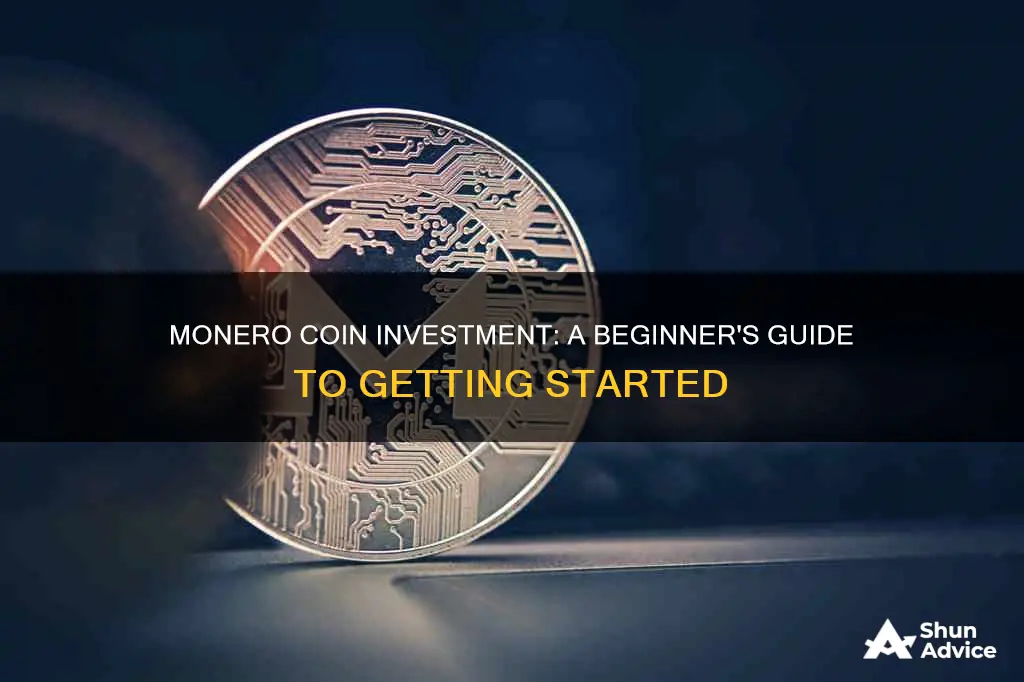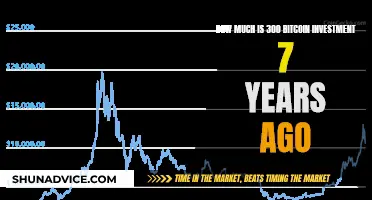
Monero (XMR) is a privacy-focused cryptocurrency that allows users to make transactions privately and anonymously. Unlike other cryptocurrencies, where transactions are publicly viewable on the blockchain, Monero uses cryptographic techniques to obscure sender and receiver information and transaction amounts. This makes it difficult to trace the flow of funds while maintaining user anonymity.
Monero was launched in 2014, and its blockchain is intentionally opaque, disguising the identities and addresses of senders and recipients. This makes it a popular choice for users prioritising privacy, but it has also attracted scrutiny for potentially enabling illegal activities.
Investing in Monero can be done through various methods, including using a credit card or PayPal on platforms like Binance, or by first buying Bitcoin or Ethereum with fiat currency and then exchanging it for Monero through platforms like Binance or Bitfinex.
| Characteristics | Values |
|---|---|
| Launch Date | April 2014 |
| Previous Name | Bitmonero |
| Starting Price | $2.47 |
| Current Price | $310.47 |
| Circulating Supply | 15,636,799 XMR |
| Developer Count | 30 |
| Type of Cryptocurrency | Alt coin |
| Privacy Features | Stealth addresses, ring signatures, ring confidential transactions |
| Wallet Options | Ledger Nano X, MyMonero, Exodus |
| Exchange Options | Binance, Bitfinex, HitBTC, Poloniex, Bithumb, Bittrex, Cryptopia, Coinbase, Kraken, Local Monero, StealthEX |
What You'll Learn

Getting a Monero wallet
To start investing in Monero, you need to get a Monero wallet. The official website recommends visiting their Downloads page to get the right wallet for your needs. Monero wallets are available for a variety of platforms and contain everything you need to use Monero immediately after installation.
There are two main types of Monero wallets: hardware wallets and software wallets. Hardware wallets, such as Ledger Nano X, offer the most secure way to store your Monero private key offline while still allowing you to send XMR through a desktop interface. However, they come with a cost.
If you don't want to incur the cost of a hardware wallet, you can opt for a free software wallet. The official desktop wallet from the Monero developers is a recommended option. MyMonero, a free hosted Monero account service, is also a convenient choice. It doesn't require you to download the full Monero desktop wallet, but it does offer strong privacy and security features. MyMonero is available for Mac, Windows, Linux, Android, and iOS, and it also offers a web wallet for quick access.
Another popular software wallet option is Exodus, which supports not only XMR but also over 100 different crypto assets. Exodus features a built-in exchange, allowing you to easily swap XMR for other cryptocurrencies and vice versa.
Regardless of the wallet you choose, ensuring the security of your wallet is of utmost importance. Many investors have lost their Monero coins due to improper wallet security. Therefore, it is crucial to prioritize the safety of your wallet and private keys to protect your investment.
Doggy Coin Investment: Getting Started and Making Profits
You may want to see also

Locating your Monero address
To locate your Monero address, you can follow these steps:
- If you are using the Monero Wallet GUI, you can find your unique address in the first line of the interface. This is your "plain" address.
- Alternatively, you can locate your address in the
.address.txt file, which is stored in the directory of your wallet files. For Windows, this is typically in the Documents\Monero folder, while for Mac OS X and Linux, it is in the ~/Monero folder. - If you are using a mobile wallet, such as Cake Wallet, you can click on the "Receive" button, and your address will pop up.
- You can also access your address by going to your address book, selecting "My Wallet" or "Primary Address", and your main wallet address will be displayed.
It is important to keep your Monero address and keys secure and not to share them with anyone. Additionally, when sending Monero, you only need the recipient's address, as it is designed to protect the privacy of both sender and receiver.
Drip Coin: Worthy Investment or Just Another Crypto Risk?
You may want to see also

Finding an XMR exchange
As with many other cryptocurrencies, you can't buy XMR directly with fiat money. Instead, you'll need to first buy another cryptocurrency, such as Bitcoin (BTC) or Ethereum (ETH), and then exchange that for XMR.
There are several exchanges that allow you to buy XMR with BTC or ETH. These include:
- Binance
- Bitfinex (no longer accepts US customers)
- HitBTC
- Poloniex
- Bithumb
- Bittrex
- Cryptopia
To buy XMR using one of these exchanges, you'll first need to sign up for an account and then deposit your BTC or ETH. Once you have a balance, you can exchange it for XMR.
Another option is to use a credit or debit card to buy XMR directly. This can be done through an exchange like Local Monero, which brings together buyers and sellers and offers a wide variety of payment options. However, it's important to note that buying XMR with a credit or debit card may require additional verification steps.
It's also worth mentioning that, due to the privacy-focused nature of XMR, some major exchanges do not support it. For example, while you can buy XMR on Binance, it is not supported by Coinbase.
The Ultimate Guide to Buying Bitcoin and Crypto Investing
You may want to see also

Depositing money and buying XMR
Now that you have your wallet and know your XMR address, it's time to deposit some money and buy some Monero. Here are the steps to follow:
- Choose an Exchange: Select a reputable exchange that allows you to purchase XMR directly with fiat currency or offers crypto-to-crypto transactions. Examples include Kraken, Binance, Cryptopia, and Coinbase. The availability of exchanges may depend on your location.
- Sign Up and Verify Your Account: Visit the website of your chosen exchange and sign up by providing the required personal information. You may also need to verify your identity by submitting documents, such as a government-issued ID or proof of residence. This process may take some time, so be patient.
- Deposit Funds: After your account is verified, you can deposit funds into your exchange account. You can typically do this via bank transfer, credit/debit card, or by depositing cryptocurrency that you already own. Each exchange will have its own instructions for depositing funds, so follow the provided steps carefully.
- Purchase XMR: Once your funds are available in your exchange account, you can proceed to buy XMR. Look for the "Buy XMR" or "Trade" section of the platform, where you can specify the amount of fiat currency or cryptocurrency you want to use to purchase XMR. Review the transaction details carefully before finalising the purchase.
- Withdraw XMR to Your Wallet: After successfully purchasing XMR, it is recommended to withdraw your coins from the exchange and store them in your personal wallet. This ensures that you have full control over your XMR and adds an extra layer of security. Locate the withdrawal section on the exchange platform and enter your XMR wallet address when prompted. Confirm the withdrawal, and your XMR will be sent to your wallet.
Remember to always do your own research and understand the risks associated with investing in cryptocurrencies. The value of Monero can fluctuate, and there are potential regulatory and security concerns due to its privacy-focused nature.
The Bitcoin Investment Trust: A Comprehensive Guide
You may want to see also

Withdrawing your coins to your wallet
Withdrawing your Monero coins to your wallet is a straightforward process, but it's essential to follow the steps carefully to ensure the security of your funds. Here's a detailed guide on how to withdraw your Monero (XMR) coins to your wallet:
- Login to Your Exchange Account: Access your account on the cryptocurrency exchange platform you're using, such as Bitfinex or Poloniex.
- Navigate to the Withdrawal Page: Find the page dedicated to withdrawals or deposits and withdrawals. This is usually found in the account settings or wallet section of the platform.
- Enter Withdrawal Details: You will need to input the amount of XMR you wish to withdraw and the address of your Monero wallet. Double-check that the wallet address is correct to avoid any issues.
- Follow Platform Instructions: Each platform may have slightly different processes. For example, on Bitfinex, you need to check a checkbox to confirm your awareness of the conditions for auto-withdrawal processing.
- Confirm the Withdrawal: After reviewing the details, click on the button to request or confirm the withdrawal. This will initiate the transfer of your XMR coins from the exchange to your personal wallet.
- Monitor the Transaction: Keep an eye on the transaction status to ensure it goes through successfully. You may be able to track the progress through your exchange account or by using a blockchain explorer with your transaction ID.
It's important to note that some platforms may have specific requirements or updates, such as changes to payment IDs. Always refer to the official documentation or support resources provided by your chosen platform for the most accurate and up-to-date instructions. Additionally, remember to secure your wallet and keep your private keys safe to protect your Monero coins.
Dogecoin Investing: Strategies for Earning Money
You may want to see also
Frequently asked questions
You can't buy XMR directly with fiat currency. Instead, you need to first buy Bitcoin (BTC) or Ethereum (ETH) with fiat currency on an exchange like Coinbase, and then exchange your BTC or ETH for XMR on another exchange like Binance, Bitfinex, HitBTC, Poloniex, Bithumb, or Bittrex.
Monero is a privacy-focused cryptocurrency that was launched in 2014. It is designed to allow transactions to take place privately and with anonymity, obscuring the identities of senders and recipients.
Monero uses advanced cryptographic techniques, such as ring signatures, stealth addresses, and Ring Confidential Transactions (RingCT), to obfuscate transaction details and make it difficult to trace the flow of funds.
You can store your XMR in a hardware wallet, such as the Ledger Nano X, or a software wallet, such as the official desktop wallet from the Monero developers or the MyMonero web wallet.
Investments in Monero are riskier than investments in stocks due to the volatility of cryptocurrency exchange rates and the relatively new nature of the financial instrument. Additionally, the privacy features of Monero have attracted scrutiny from regulators and governments, and it has been associated with illicit activities.







